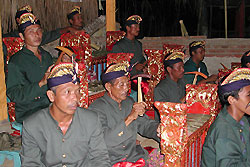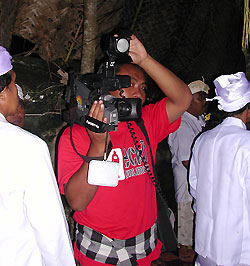| Period: 7 January - 5 March
2004. Country: Indonesia |
|
(1) Development of Tradition in Indonesian Balinese Culture: The Case Studies of Gamelan Music in Ubud Village, Gianyar Regency and Bungkulan Village, Buleleng Regency |
| MASAKI Keiko (Division of Southeast Asian Area Studies) |
| Key Words: Gamelan Music, Kuno, Modern, Balinese Traditional Culture, Development |

Gamelan orchestra performing at a temple ritual in Bungkulan village, Buleleng regency |
(2) Bali, Indonesia is a small island equal in size to Ehime Prefecture in Japan. Yet, within this small area, tens of thousands of temples are found, and rituals are held in one temple or another almost everyday, where gamelan music using bronze percussion orchestra resounds throughout the temples. Bali has a remarkably rich and vibrant traditional culture which has by no means been threatened by modern lifestyle, but rather is increasing in its complexity as it continues to develop.
The focus of my research from April 2001 to January 2003 was Balinese Gamelan music. I found that the development in Balinese traditional culture has two patterns. In the region with much tourism, new gamelan music is created actively through composition and performance. Such new creativity is displayed in shows for tourists. On the other hand, such new creativity is not found in the regions with little tourism. Here, classical gamelan instruments are used for music entirely focused on ritual purposes in the temple. I present these two divergent tendencies in the musical culture as modern (modern in Indonesian) and classical (kuno in Indonesian). Both of these musical tendencies are represented at the big Balinese cultural event, the Balinese Art Festival which is held every June. The newly created gamelan music with complicated melodies and beautiful spectacular dances may seem quite different from the traditional style. However, at the same time as displaying modern style, it is also shown that “Balinese classical culture” is inherited as an integral part of Balinese culture. Therefore, I emphasize that there is continuity between kuno and modern styles, moreover, Balinese music has been developed through the interaction between both styles.
In this thesis, I focus on gamelan music group activities in Bungkulan, which represents high kuno style and Ubud, which represents high modern style. Through looking at changes in social functions regarding gamelan and through musical analysis, I clarify the background from which this difference of style emerged in these two villages. This leads to an understanding of the dynamics and manifold nature of Balinese culture. Moreover, the purpose is to clarify how these differences influence the development and succession of kuno and modern styles of culture and the dynamics of Balinese culture.
| (3) In the present research, I examined the images presented in the media of the two divergent styles: the modern style in Ubud, and classical kuno style in Bungkulan, with particular focus on Bali TV, the first commercial television broadcasting station in Bali, which began broadcasting in May 2002. It has the purpose of independently providing information about Bali by Balinese. In the beginning, I expected to see frequent broadcasts of rituals, traditions and other ceremonies from many villages throughout Bali. However, in analyzing the broadcasted programs, it was found that the organizers of rituals in Gianyar, the self-proclaimed cultural center of Bali, purchase broadcasting rights from Bali TV using the economic power gained by the profits of tourism, and use them to heavily advertise their modern style. By contrast, traditions from regions with little tourism are hardly broadcasted. Just as Balinese culture appreciated by outsiders is primarily those of the center, where heavy tourism is observed, so, Balinese culture as presented by Bali TV also focuses on the modern in the rich economic region, leading to considerable regional bias in the information on Balinese culture received by Balinese themselves. |
 |
| |
A camera crew from Bali TV in action |
|


 21st Century COE Program
-Aiming for COE of Integrated Area Studies-
21st Century COE Program
-Aiming for COE of Integrated Area Studies-